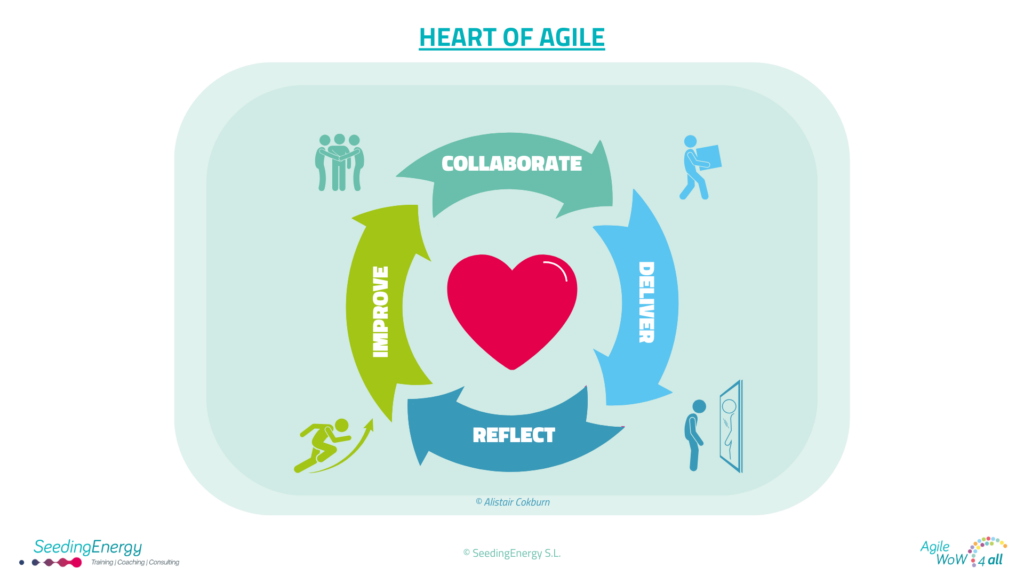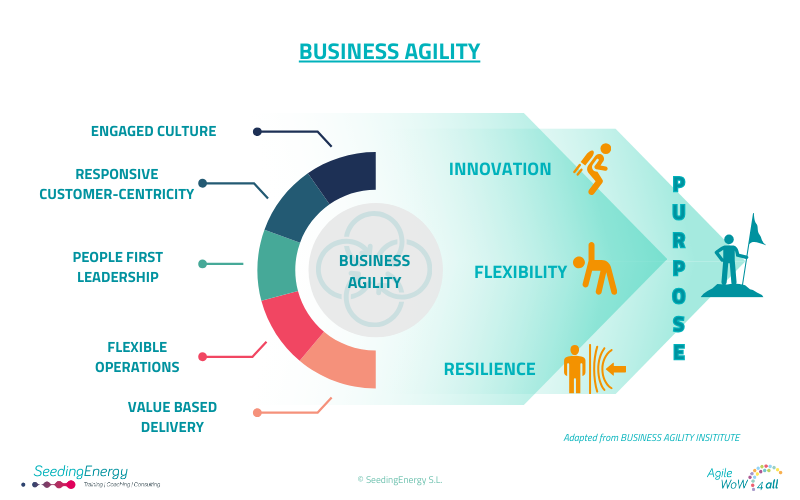

12/04/2024
Beyond AGILE: Mastering the symphony of Business Adaptability
In the swiftly evolving business sphere, the terms “Agile” and “Business Agility” frequently surface as crucial elements for organizational success. Though both strive for adaptability and flexibility, they signify distinct concepts within the realm of strategic management. This article delves into the nuances, shedding light on how Agile methodology and Business Agility contribute to an organization’s resilience and responsiveness.
AGILE METHODOLOGY: A METHODICAL APPROACH TO ITERATIVE DEVELOPMENT
Originating in software development, Agile methodology has transcended its origins to become a versatile project management and product development approach. It prioritizes flexibility, collaboration, and customer satisfaction.
For example, in software development, Agile’s iterative cycles mean regular releases of software features, allowing developers to respond promptly to user feedback and evolving requirements.

Key Principles of Agile: Iterative Development, Collaboration, Customer Feedback, and Embracing Change
Agile principles are deeply rooted in the concept of iterative development, which encourages teams to break down projects into smaller, more manageable iterations. By doing so, Agile facilitates adaptability and responsiveness throughout the entire development lifecycle. This iterative approach allows for constant evaluation and adjustment, ensuring that teams can quickly respond to changing requirements and evolving customer needs.
Collaboration and communication are fundamental aspects of Agile methodology. Regular meetings and open lines of communication ensure that all team members and stakeholders are aligned and working towards a common goal. This collaborative environment fosters a sense of shared ownership and accountability, ultimately leading to more successful project outcomes.
One of the cornerstones of Agile is the incorporation of customer feedback loops. By actively seeking and incorporating input from end-users throughout the development process, Agile teams can make continuous adjustments to meet user needs and preferences. This ongoing feedback loop ensures that the final product not only meets but exceeds customer expectations.
What sets Agile apart from traditional development methodologies is its willingness to embrace change. Rather than resisting or avoiding change, Agile welcomes it as an opportunity for improvement. This mindset creates an environment where adaptability is not just tolerated but embraced as a catalyst for innovation and progress.
Agile teams are encouraged to constantly assess their processes, experiment with new approaches, and adapt as necessary to deliver the best possible outcomes. In summary, Agile principles promote iterative development, collaboration, communication, and customer-centricity. By embracing change and creating an adaptive environment, Agile enables teams to continuously improve, innovate, and deliver high-quality products that truly meet customer needs.
Alistair Cockburn, co-author of the Agile Manifesto, simplifies it with the Heart of Agile. Agile emphasizes the importance of collaboration among team members to successfully deliver value. It encourages reflection on both the delivered value and the working methods employed, fostering a culture of continuous improvement.
By actively engaging in collaboration, teams can enhance communication and problem-solving, leading to better outcomes. Regularly reflectingon the deliveredvalue helps teams understand their progress and make necessary adjustments. Additionally, reflecting on the working methods used allows for identification of areas that need improvement, enabling teams to optimize their processes and enhance overall efficiency. This iterative approach empowers teams to adapt and evolve, ultimately driving success in their projects.
Agile is about collaborating to deliver value, reflecting on both the delivered value and the working methods used, and continually improving.
BUSINESS AGILITY: A HOLISTIC ORGANIZATIONAL SYMPHONY
While Agile hones in on project execution, Business Agility orchestrates a broader organizational symphony. It encapsulates an organization’s ability to adapt, innovate, and efficiently respond to change. Unlike Agile, which is more project-specific, business agility extends its reach across an organization’s entire strategic and cultural landscape.

Key Components of Business Agility: Strategic Flexibility, Cultural Adaptability, Leadership Alignment, and Cross-Functional Collaboration
Strategic flexibility is exemplified by companies that swiftly pivot their market strategies in response to changing consumer demands. Take Netflix, for instance, which evolved from a DVD rental service to a global streaming giant, showcasing strategic adaptability.
Cultural adaptability involves fostering a workplace where experimentation is encouraged, learning from failures is seen as a positive, and processes are in a constant state of improvement. A prime example is Google’s “20% time” policy, allowing employees to dedicate a fifth of their work hours to personal projects, fostering innovation and creativity.
Leadership alignment is evident when leaders champion a culture of openness and collaboration. Apple, under Steve Jobs’ leadership, exemplified this by fostering a culture of innovation that extended from top to bottom.
Finally, cross-functional collaboration breaks down silos and accelerates decision-making. Amazon’s cross-functional teams, such as the ones responsible for the development of the Kindle or Alexa, exemplify this collaborative approach.
STRIKING THE BALANCE FOR ORGANIZATIONAL SUCCESS
In conclusion, while Agile methodology serves as a specific tool for project management, business agility is the broader organizational capability that encompasses strategic, cultural, and leadership dimensions. Agile methodology and Business Agility are not mutually exclusive; instead, they complement each other to create a symphony of organizational success.
Employing Agile practices within a broader framework of Business Agility enables companies to fine-tune project management while simultaneously nurturing a culture of adaptability and innovation. As organizations strive for excellence in an ever-changing landscape, the harmonious integration of Agile and Business Agility becomes the melody of sustained success. Organizations must strike a balance, leveraging Agile methodologies for specific projects while cultivating a broader culture of business agility.
The synergy between the two fosters an environment of adaptability, ensuring organizations can navigate the dynamic business landscape with resilience, flexibility, and innovation with an obsession with creating value for the customer.
We can help and accompany you and your organization to become more agile and resilient. Should you be interested in learning more, please do not hesitate to contact us!
